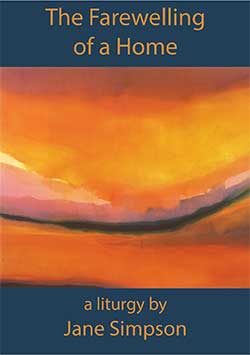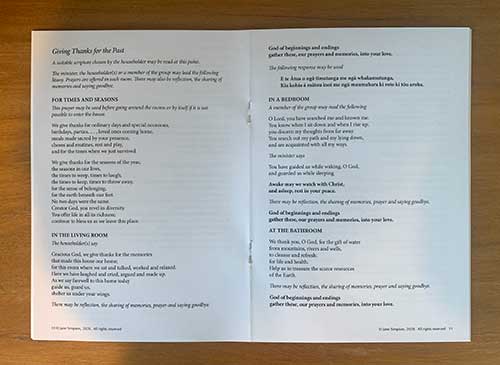
The Farewelling of a Home
a liturgy by Jane Simpson
21 pages
Poiema Liturgies – Christchurch
There are rites to bless a home – in The Episcopal Church (here, page 156, a shorter rite page 166); in The Church in Wales (here); in the Anglican Church in Aotearoa, New Zealand and Polynesia (here). But, Dr Jane Simpson recognised that there are no rites for the farewelling of a home, and has responded by creating such a rite.
There are rites for the end of a life, for the end (deconsecration) of a church building, even for the end of a ministry and pastoral relationship… Christchurch lost many buildings and homes through the destructive earthquakes of 2010-11. The desire to farewell one’s home highlighted that no rite or resource(s) existed to meet this need.
This farewell rite reflects the approach and layout of A New Zealand Prayer Book He Karakia Mihinare o Aotearoa (NZPBHKMA). It is “led by the householder(s) or by a person they choose.” The Farewelling of a Home (FH) page 5. This person leading is termed “The Minister“. This follows the NZPBHKMA approach that the one leading a service is termed “The Minister” – it is not a term used for a role requiring ordination. On occasion in FH, the leader (minister) is distinguished from the householder(s).
The leader’s material is presented in regular type. The response and material of others gathered is presented in bold. Instructions are given in italics. There is some use of Te Reo Māori, and the intention is that the whole rite become available in Te Reo Māori.
There are options for a number of contexts, including for those leaving later in life, after having left the home, after a death, after natural disaster, and so forth.
Like its ‘model’, The Blessing of a Home, (NZPBHKMA pp 762-775), there are moments in different parts of the home: the living room, bedroom, bathroom, study, garden, kitchen, dining area. Like NZPBHKMA, the language is gender-inclusive for humans, and has a variety of images, including gender-specific ones for God. Jane’s gifting as a poet shines through.
Also, like its ‘model’, The Blessing of a Home, (NZPBHKMA pp 762-775) and other rites in NZPBHKMA, the responses and people’s parts need to be read from a text – they are not simple, memorised refrains. This means that each participant needs access to a book. [There is an added point that care needs to be taken in moving around a property, possibly with eyes on a text]. An alternative approach is modelled by the Church of Wales, where the leader has a resource, and everyone else can participate with simple responses.
There is currently no PDF, Kindle, or other online version, so one cannot use, for example, a phone instead of (alongside others using) a bound booklet.
FH also follows the NZPBHKMA model in being gender-inclusive in speaking about humans, and expansive and sometimes gender-specific language when speaking about God. I did not spot a gender-specific pronoun in relation to God.
This rite is an allowed rather than authorised rite in the Anglican Church in Aotearoa, New Zealand and Polynesia – this means you can construct your own farewelling liturgy; do be attentive in adapting that it is appropriate to contact the copyright holder to adapt.
On FH page 18 it says, “The liturgy… may also be adapted for deconsecrating a church”. This is a strong reminder that, in a Church that has possibly had the most deconsecrations of church buildings over the shortest period of time, certainly in my diocese after the devastating destruction of thousands of earthquakes, there is no agreed rite for deconsecrating a church building.
Beautifully produced, thoughtfully and poetically composed, I recommend Jane’s rite as a wonderful pastoral response to a strong human need that has, until now, been neglected.



